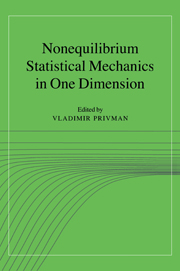Book contents
- Frontmatter
- Contents
- Contributors
- Preface
- Part I Reaction-Diffusion Systems and Models of Catalysis
- Part II Kinetic Ising Models
- 4 Kinetic Ising models with competing dynamics: mappings, correlations, steady states, and phase transitions
- 5 Glauber dynamics of the Ising model
- 6 1D kinetic Ising models at low temperatures—critical dynamics, domain growth, and freezing
- Part III Ordering, Coagulation, Phase Separation
- Part IV Random Adsorption and Relaxation Processes
- Part V Fluctuations in Particle and Surface Systems
- Part VI Diffusion and Transport in One Dimension
- Part VII Experimental Results
- Index
- Abbreviations
5 - Glauber dynamics of the Ising model
Published online by Cambridge University Press: 18 December 2009
- Frontmatter
- Contents
- Contributors
- Preface
- Part I Reaction-Diffusion Systems and Models of Catalysis
- Part II Kinetic Ising Models
- 4 Kinetic Ising models with competing dynamics: mappings, correlations, steady states, and phase transitions
- 5 Glauber dynamics of the Ising model
- 6 1D kinetic Ising models at low temperatures—critical dynamics, domain growth, and freezing
- Part III Ordering, Coagulation, Phase Separation
- Part IV Random Adsorption and Relaxation Processes
- Part V Fluctuations in Particle and Surface Systems
- Part VI Diffusion and Transport in One Dimension
- Part VII Experimental Results
- Index
- Abbreviations
Summary
Recent results for the Glauber-type kinetic Ising models are reviewed in this chapter. Exact solutions for chains and simulational results for the dynamical exponents for square and cubic lattices are given.
Introduction
A study on the dynamical behavior of the Ising model must begin with the introduction of a temporal evolution rule, because the Ising model itself does not have any a priori dynamics naturally introduced from the kinetic theory. Various kinds of dynamics are possible and some are useful to describe and predict physical phenomena or to make simulation studies of the equilibrium state. The Ising model with an appropriately defined temporal evolution rule is called the kinetic Ising model.
The statistical mechanical studies of the dynamical behavior in and around the equilibrium state started in the 1950s. During that decade, theoretical and computational developments provided a breakthrough and advanced such studies. The Kubo theory and its successful application established the linearly perturbed regime around the equilibrium state generally treated by methods of statistical mechanics. It gave a means of investigating the dynamic behavior of macroscopic systems. Another great advance in that decade was the application of computing machines to statistical physics. Dynamical Monte Carlo (MC) simulation on computers gave rise to the problem of computational efficiency, which is related to the dynamical behavior of the system, although this aspect became clear rather recently, in the 1980s.
- Type
- Chapter
- Information
- Nonequilibrium Statistical Mechanics in One Dimension , pp. 93 - 110Publisher: Cambridge University PressPrint publication year: 1997



